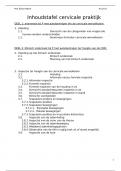Prof. Elissa Maleve AJ 22-23
Inhoudstafel cervicale praktijk
DEEL 1: anamnese bij P met aandoeningen thv de cervicale wervelkolom
1. Inleiding
1.1. Overzicht van de categorieën van vragen die
kunnen worden onderscheiden
1.2. Anamnese formulier cervicale wervelkolom
DEEL 2: Klinisch onderzoek bij P met aandoeningen ter hoogte van de CWK
2. Inleiding op het klinisch onderzoek
2.1. Klinisch onderzoek
2.2. Planning van het klinisch onderzoek
3. Inspectie ter hoogte van de cervicale wervelkolom
3.1. Inleiding
3.2. Informele versus formele inspectie
3.2.1. Informele inspectie
3.2.2. Formele inspectie
3.3. Formele inspectie van de houding in zit
3.4. Overzicht aandachtspunten inspectie in zit
3.5. Overzicht aandachtspunten inspectie in stand
3.6. Klinische voorbeelden
3.7. Scapulaire posities en bewegingen
3.7.1. Scapulaire posities
3.7.2. Scapulaire bewegingen
3.7.2.1. Translatie bewegingen
3.7.2.2. Rotatie bewegingen
3.7.3. Scapulaire posities en musculaire disfuncties
3.8. Inspectie van de ademhaling
3.8.1. Inspectie van de vorm van de thorax
3.8.2. Inspectie van de adembeweging
3.8.3. Afwijkend ademhalingspatroon
3.8.4. Observatie van de AH in ruglig (ook zit of stand mogelijk)
3.9. Inspectie van de huid
1
, Prof. Elissa Maleve AJ 22-23
4. Palpatie thv de cervicale wervelkolom
4.1. Overzicht palpatie CWK
4.2. Anterieur
4.2.1. Benige structuren
4.2.1.1. Os hyoideum (tongbeen)
4.2.1.2. Larynx (strottenhoofd)
Cartilago thyroidea
Cartilago criciodea
Tuberculum caroticum
4.2.2. Weke delen
4.2.2.1. Anterieure driehoek (ruglig)
4.2.2.2. M sternocleidomastoideus (ruglig)
4.2.2.3. Pulsaties van de a. carotis communis (ruglig)
4.2.2.4. Fossa supraclavicularis (ruglig)
4.3. Posterieur
4.3.1. Benige structuren
4.3.1.1. Protuberantia occipitalis externa (ruglig)
4.3.1.2. Linea nuchae superior (ruglig)
4.3.1.3. Processus mastoideus (ruglig)
4.3.1.4. Processus spinosi C2-T1 (ruglig)
4.3.1.5. Zygapophysiale (facet) gewricht (ruglig)
4.3.1.6. Os costa prima (R1) (ruglig)
4.3.2. Weke delen
4.3.2.1. Ligamentum nuchae superior (zit)
4.3.2.2. Posterieur driehoek (ruglig)
4.3.2.3. Mm scaleni (ruglig)
4.3.2.4. Vaat zenuw bed (neurovasculaire bundel) (ruglig)
4.3.2.5. M trapezius pars descendens (zit)
4.3.2.6. M levator scapulae (zit of zijlig)
4.4. Myofaciale triggerpunten (MTP’s)
4.4.1. Klinische karakteristieken
4.4.2. Enkele veel voorkomende MTP’s ter hoogte van de CWK
2
Inhoudstafel cervicale praktijk
DEEL 1: anamnese bij P met aandoeningen thv de cervicale wervelkolom
1. Inleiding
1.1. Overzicht van de categorieën van vragen die
kunnen worden onderscheiden
1.2. Anamnese formulier cervicale wervelkolom
DEEL 2: Klinisch onderzoek bij P met aandoeningen ter hoogte van de CWK
2. Inleiding op het klinisch onderzoek
2.1. Klinisch onderzoek
2.2. Planning van het klinisch onderzoek
3. Inspectie ter hoogte van de cervicale wervelkolom
3.1. Inleiding
3.2. Informele versus formele inspectie
3.2.1. Informele inspectie
3.2.2. Formele inspectie
3.3. Formele inspectie van de houding in zit
3.4. Overzicht aandachtspunten inspectie in zit
3.5. Overzicht aandachtspunten inspectie in stand
3.6. Klinische voorbeelden
3.7. Scapulaire posities en bewegingen
3.7.1. Scapulaire posities
3.7.2. Scapulaire bewegingen
3.7.2.1. Translatie bewegingen
3.7.2.2. Rotatie bewegingen
3.7.3. Scapulaire posities en musculaire disfuncties
3.8. Inspectie van de ademhaling
3.8.1. Inspectie van de vorm van de thorax
3.8.2. Inspectie van de adembeweging
3.8.3. Afwijkend ademhalingspatroon
3.8.4. Observatie van de AH in ruglig (ook zit of stand mogelijk)
3.9. Inspectie van de huid
1
, Prof. Elissa Maleve AJ 22-23
4. Palpatie thv de cervicale wervelkolom
4.1. Overzicht palpatie CWK
4.2. Anterieur
4.2.1. Benige structuren
4.2.1.1. Os hyoideum (tongbeen)
4.2.1.2. Larynx (strottenhoofd)
Cartilago thyroidea
Cartilago criciodea
Tuberculum caroticum
4.2.2. Weke delen
4.2.2.1. Anterieure driehoek (ruglig)
4.2.2.2. M sternocleidomastoideus (ruglig)
4.2.2.3. Pulsaties van de a. carotis communis (ruglig)
4.2.2.4. Fossa supraclavicularis (ruglig)
4.3. Posterieur
4.3.1. Benige structuren
4.3.1.1. Protuberantia occipitalis externa (ruglig)
4.3.1.2. Linea nuchae superior (ruglig)
4.3.1.3. Processus mastoideus (ruglig)
4.3.1.4. Processus spinosi C2-T1 (ruglig)
4.3.1.5. Zygapophysiale (facet) gewricht (ruglig)
4.3.1.6. Os costa prima (R1) (ruglig)
4.3.2. Weke delen
4.3.2.1. Ligamentum nuchae superior (zit)
4.3.2.2. Posterieur driehoek (ruglig)
4.3.2.3. Mm scaleni (ruglig)
4.3.2.4. Vaat zenuw bed (neurovasculaire bundel) (ruglig)
4.3.2.5. M trapezius pars descendens (zit)
4.3.2.6. M levator scapulae (zit of zijlig)
4.4. Myofaciale triggerpunten (MTP’s)
4.4.1. Klinische karakteristieken
4.4.2. Enkele veel voorkomende MTP’s ter hoogte van de CWK
2



